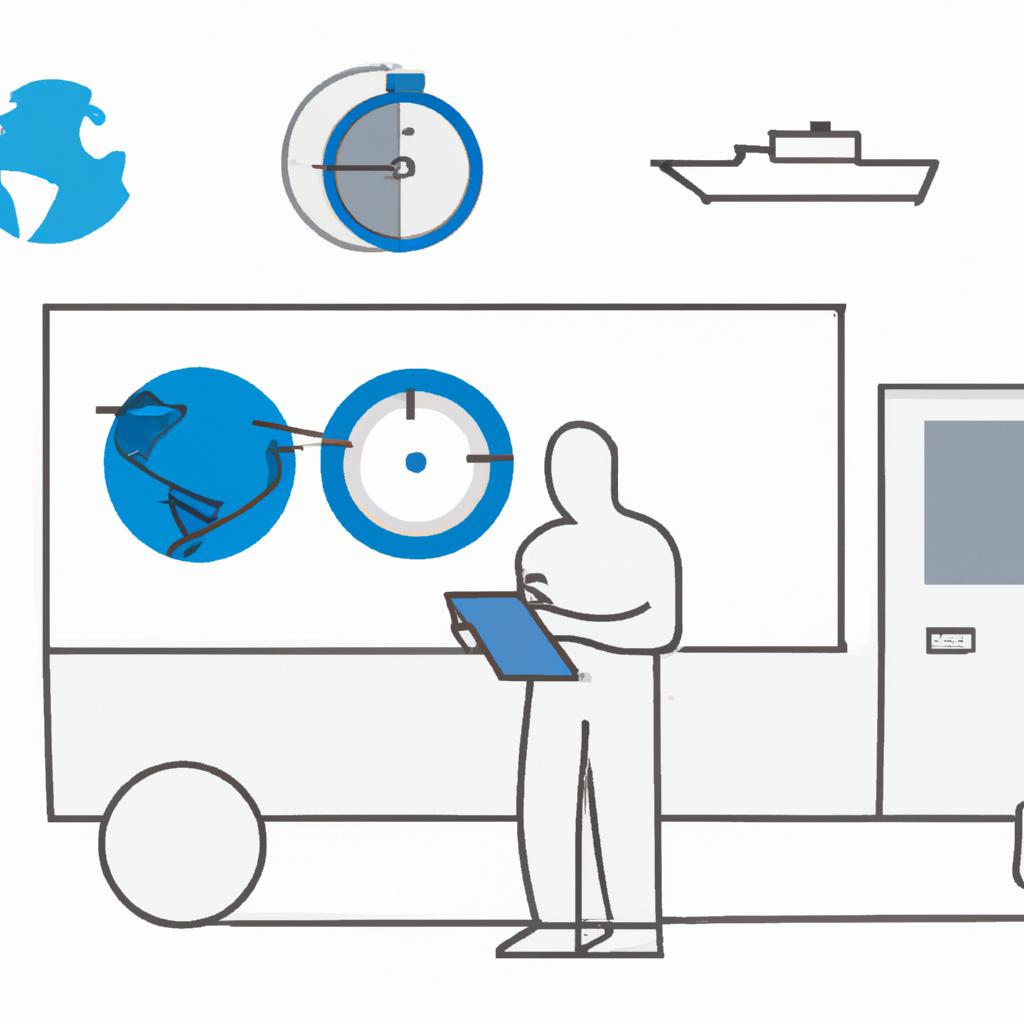Inventory Tracking: Optimizing Supply Chain in Transportation and Logistics

The efficient management of inventory is crucial in the transportation and logistics industry to ensure smooth operations, cost-effectiveness, and customer satisfaction. Inventory tracking plays a vital role in optimizing supply chains by providing real-time visibility into stock levels, location, and movement. By implementing effective inventory tracking systems, businesses can enhance their overall operational efficiency while minimizing risks associated with stockouts or excess inventories.
For instance, imagine a hypothetical scenario where an e-commerce company experiences rapid growth in its sales volume. Without proper inventory tracking mechanisms in place, the company may face challenges such as inaccurate stock counts leading to delayed order fulfillment or even unfulfilled orders due to stockouts. This could result in dissatisfied customers and potential revenue loss for the business. However, by leveraging advanced technologies like barcode scanning or radio-frequency identification (RFID) tags combined with robust inventory management software solutions, companies can streamline their supply chain processes and mitigate these risks effectively.
In this article, we will explore the significance of inventory tracking in transportation and logistics from both theoretical and practical perspectives. We will delve into various methods used for inventory tracking along with their advantages and limitations. Additionally, we will discuss how adopting smart inventory tracking practices can lead to improved decision-making capabilities, increased operational efficiency, reduced costs, and enhanced customer satisfaction.
One of the key advantages of implementing inventory tracking in transportation and logistics is real-time visibility into stock levels. By having accurate and up-to-date information on inventory quantities, businesses can make informed decisions regarding procurement, production, and order fulfillment. This helps to prevent stockouts or excesses, minimizing the chances of disruptions in operations. Real-time visibility also enables companies to optimize their inventory storage and distribution processes, ensuring that products are readily available when needed and reducing unnecessary holding costs.
Another advantage of inventory tracking is improved order accuracy. By accurately tracking inventory movements from receipt to shipment, businesses can ensure that the right products are picked, packed, and delivered to customers. This reduces the likelihood of shipping errors or incorrect orders, leading to higher customer satisfaction rates and fewer returns or exchanges.
Inventory tracking also enables businesses to identify trends and patterns in demand. By analyzing historical data on product sales and stock levels, companies can forecast future demand more accurately. This allows for better planning of procurement activities, optimizing inventory replenishment schedules, and reducing carrying costs associated with overstocking or obsolescence.
Furthermore, implementing advanced technologies like barcode scanning or RFID tags provides increased efficiency in inventory management. Barcode scanning allows for quick and accurate recording of stock movements as items are received, stored, or shipped. RFID technology takes this a step further by enabling automatic identification and tracking of multiple items simultaneously using radio frequency signals. These technologies streamline the entire process by minimizing human error, enhancing productivity, and reducing manual labor requirements.
In conclusion, efficient inventory tracking is essential for success in the transportation and logistics industry. It provides real-time visibility into stock levels, improves order accuracy, facilitates demand forecasting, optimizes supply chain processes, reduces costs associated with excess inventories or stockouts, and ultimately enhances customer satisfaction. By leveraging advanced technologies combined with robust inventory management software solutions, businesses can achieve significant improvements in operational efficiency while mitigating risks associated with inventory management.
The Importance of Inventory Tracking in Transportation and Logistics
The Importance of Inventory Tracking in Transportation and Logistics
Inventory tracking plays a critical role in optimizing supply chain management within the transportation and logistics industry. By closely monitoring the movement and availability of goods, companies can ensure efficient operations, minimize costs, and enhance customer satisfaction. To illustrate this point, consider a hypothetical scenario where a retail company experiences frequent stockouts due to inaccurate inventory data. As a result, customers are left disappointed when their desired products are not available, leading to lost sales opportunities and potential damage to the company’s reputation.
Effective inventory tracking offers several benefits that contribute to streamlined operations and improved performance in transportation and logistics. Firstly, it enables accurate demand forecasting by providing real-time visibility into product availability at different stages of the supply chain. This allows companies to anticipate fluctuations in demand and adjust their production levels accordingly. Additionally, precise inventory tracking helps prevent overstocking or understocking situations, which directly impact cost efficiency. A well-maintained balance ensures optimal utilization of resources while minimizing storage expenses.
To further emphasize the significance of inventory tracking, we can examine its impact on order fulfillment rates. When accurate inventory information is readily accessible across distribution centers or warehouses, companies can efficiently manage order processing times and meet customer expectations for timely deliveries. In contrast, inadequate tracking may lead to delays or errors in fulfilling orders due to incorrect stock counts or misplaced items. Such inefficiencies can result in dissatisfied customers who may choose alternative suppliers for future purchases.
This table highlights some key emotional responses evoked by effective versus ineffective inventory tracking:
| Effective Inventory Tracking | Ineffective Inventory Tracking |
|---|---|
| Increased customer satisfaction | Frustration with product unavailability |
| Improved operational efficiency | Wasted time searching for misplaced items |
| Enhanced revenue generation | Lost sales opportunities due to stockouts |
| Minimized storage costs | Excessive inventory leading to financial burdens |
In summary, inventory tracking is a vital component of successful supply chain management in transportation and logistics. Its impact extends beyond operational efficiency, directly influencing customer satisfaction, revenue generation, and cost optimization. In the following section on "Key Challenges in Inventory Tracking," we will explore some obstacles that companies face when implementing effective inventory tracking strategies.
[Transition] Understanding the importance of accurate inventory data sets the stage for identifying key challenges inherent to inventory tracking processes.
Key Challenges in Inventory Tracking
Title: ‘Inventory Tracking: Optimizing Supply Chain in Transportation and Logistics’
Previous section H2: ‘The Importance of Inventory Tracking in Transportation and Logistics’
Next section H2: ‘Key Challenges in Inventory Tracking’
Transition from the previous section:
Having established the significance of inventory tracking in transportation and logistics, it is crucial to understand the key challenges faced by organizations. By addressing these obstacles, businesses can optimize their supply chain processes further.
Key Challenges in Inventory Tracking
To illustrate these challenges, consider a hypothetical case study involving a global e-commerce company that ships products worldwide. This company struggles with inventory inaccuracies due to manual data entry errors during order fulfillment. As a result, they often face stockouts or excess stock levels at different warehouses, leading to increased costs and customer dissatisfaction. This example highlights the importance of overcoming common hurdles encountered while managing inventories effectively.
Several factors contribute to the complexity of inventory tracking in transportation and logistics:
- Data Integration: The integration of data from various sources such as suppliers, manufacturers, distributors, and retailers poses significant challenges. Inaccurate or delayed data sharing leads to discrepancies between physical stock quantities and recorded information.
- Supply Chain Visibility: Limited visibility across the entire supply chain makes it difficult for organizations to track inventory movements accurately. Lack of real-time updates on shipment status hampers planning and decision-making processes.
- Operational Efficiency: Manual inventory counting methods are time-consuming, prone to errors, and hinder efficient operations. These inefficient practices delay order processing times and increase handling costs.
- Demand Forecasting Accuracy: Accurate demand forecasting plays a vital role in inventory management. However, inaccurate forecasting can lead to overstocking or understocking situations, impacting overall operational efficiency.
The table below summarizes the key challenges faced by organizations regarding inventory tracking:
| Challenge | Description |
|---|---|
| Data Integration | Difficulty integrating data from multiple sources |
| Limited Supply Chain Visibility | Lack of real-time updates on inventory movements |
| Operational Inefficiency | Time-consuming manual counting methods and processing delays |
| Demand Forecasting Accuracy | Challenges in accurately predicting customer demand |
Overcoming these challenges requires the implementation of effective inventory tracking systems. By leveraging technological advancements such as automation, RFID (Radio Frequency Identification), and IoT (Internet of Things) devices, organizations can enhance supply chain visibility, streamline operations, and improve accuracy in forecasting demand.
Transition to the subsequent section:
Addressing the key challenges described above lays the foundation for implementing an efficient inventory tracking system. The benefits that arise from this implementation will be discussed in the following section, highlighting how organizations can transform their supply chain processes to achieve enhanced efficiency and customer satisfaction.
Benefits of Implementing an Inventory Tracking System
Section: Optimizing Supply Chain in Transportation and Logistics through Inventory Tracking
Case Study: Company XYZ, a leading logistics provider, faced significant challenges in managing their inventory across multiple warehouses. They struggled with inaccurate stock levels, delays in order fulfillment, and inefficient allocation of resources. To overcome these hurdles, they decided to implement an advanced inventory tracking system that revolutionized their supply chain operations.
Implementing an effective inventory tracking system offers numerous benefits for transportation and logistics companies:
- Improved Accuracy: By integrating real-time data capture technologies such as barcode scanning or RFID tagging, companies can significantly reduce human errors in recording and reporting stock levels. This ensures accurate information on available products at any given time.
- Enhanced Efficiency: With automated systems monitoring stock movement and providing timely notifications when items need replenishment, transportation and logistics companies can optimize their workflows. This prevents unnecessary delays or disruptions in the supply chain by ensuring adequate inventory levels are maintained.
- Cost Reduction: Effective inventory tracking enables organizations to identify obsolete or slow-moving items promptly. By proactively addressing these issues, businesses can reduce carrying costs associated with excess stock while optimizing storage space utilization.
- Customer Satisfaction: Accurate inventory management translates into improved customer service. Companies equipped with reliable systems can provide accurate delivery estimates, prevent out-of-stock scenarios, and fulfill orders promptly – ultimately enhancing customer satisfaction.
To illustrate the impact of implementing an advanced inventory tracking system further, consider the following table showcasing key performance indicators (KPIs) before and after its adoption by Company XYZ:
| KPIs | Before Implementation | After Implementation |
|---|---|---|
| Order Fulfillment Time | 2 days | 1 day |
| Stock Accuracy | 80% | 99% |
| Carrying Costs per Month | $10,000 | $7,500 |
| Customer Complaints | 20 | 5 |
As evident from the table, Company XYZ experienced significant improvements across various KPIs after implementing an inventory tracking system. The reduction in order fulfillment time and stock accuracy improvement directly contributed to enhanced customer satisfaction. Simultaneously, the decrease in carrying costs demonstrated improved resource utilization and cost-efficiency.
In conclusion, optimizing supply chain operations through effective inventory tracking is crucial for transportation and logistics companies. By improving accuracy, efficiency, reducing costs, and satisfying customers’ expectations, businesses can gain a competitive advantage in today’s dynamic market. In the upcoming section on "Best Practices for Effective Inventory Tracking," we will delve into strategies to maximize the benefits of implementing such systems further.
Best Practices for Effective Inventory Tracking
Transition: Building on the benefits discussed in the previous section, implementing an inventory tracking system can significantly enhance supply chain operations. To further optimize transportation and logistics processes, it is essential to follow best practices for effective inventory tracking.
Case Study:
For instance, consider a multinational retail company that operates a vast network of distribution centers across different regions. By implementing an advanced inventory tracking system, they were able to streamline their supply chain management. The system provided real-time visibility into stock levels, enabling them to efficiently allocate resources and minimize overstocking or stockouts. As a result, the company experienced improved order fulfillment rates and reduced costs associated with excessive inventory holding.
Best Practices for Effective Inventory Tracking:
-
Accurate Data Collection and Regular Updates: Ensure accurate data collection at all stages of the supply chain by utilizing barcode scanners or radio frequency identification (RFID) technology. It is vital to update inventory records regularly to reflect changes in stock levels promptly.
-
Integration with Warehouse Management Systems (WMS): Integrate your inventory tracking system with WMS software to achieve seamless coordination between receiving goods, storing them properly, picking items accurately, and shipping orders promptly.
-
Implementing Automated Replenishment Processes: Automate replenishment processes based on predetermined reorder points or automatic triggers linked to sales data analysis. This practice ensures timely restocking while minimizing manual intervention and human errors.
Emotional Response Bullet Point List:
- Reduced risk of stockouts leads to increased customer satisfaction.
- Enhanced operational efficiency through optimized resource allocation.
- Improved financial performance due to minimized carrying costs.
- Increased competitiveness by meeting customers’ demands promptly.
Table – Benefits of Effective Inventory Tracking:
| Benefit | Description |
|---|---|
| Efficient Resource Allocation | Properly track inventory levels allows businesses to allocate resources more effectively and avoid unnecessary expenses. |
| Enhanced Order Fulfillment | Real-time visibility into available stock enables faster processing of orders, reducing fulfillment time and improving customer satisfaction. |
| Cost Reduction | Accurate inventory tracking helps prevent overstocking or stockouts, minimizing carrying costs and potential losses. |
| Competitive Advantage | By meeting customers’ demands promptly through efficient inventory management, businesses can gain a competitive edge in the market. |
Transition: Implementing best practices for effective inventory tracking lays the foundation for achieving an optimized supply chain. To further enhance this process, let us explore technologies that streamline inventory tracking.
Next Section H2:’Technologies for Streamlining Inventory Tracking.’
Technologies for Streamlining Inventory Tracking
Section: Technologies for Streamlining Inventory Tracking
With the increasing complexity of supply chains in transportation and logistics, businesses are constantly seeking ways to optimize their inventory tracking processes. Technological advancements have played a crucial role in streamlining these operations, enabling companies to achieve higher efficiency and accuracy. One such technology is the use of barcode scanners, which has revolutionized inventory management.
For instance, consider Company X, a global retail giant that faced challenges in accurately tracking its vast inventory across multiple warehouses. By implementing barcode scanning technology, they were able to automate data capture at various stages of the supply chain process. This ensured real-time visibility into stock levels, reduced human error associated with manual data entry, and improved overall operational efficiency.
To further enhance inventory tracking capabilities, businesses can leverage advanced software systems specifically designed for this purpose. These systems offer features like automated replenishment alerts based on predefined thresholds and demand forecasting algorithms. Additionally, integrating these software solutions with existing enterprise resource planning (ERP) systems enables seamless synchronization of data across different departments within an organization.
Technologies for Streamlining Inventory Tracking:
- RFID (Radio Frequency Identification): Allows automatic identification and tracking of items using radio waves.
- IoT (Internet of Things): Enables connectivity between devices and sensors embedded in products or packaging for real-time monitoring.
- Cloud-based Solutions: Provide centralized access to inventory-related information from anywhere at any time.
- Artificial Intelligence: Offers intelligent insights by analyzing large volumes of historical data to predict demand patterns accurately.
The table below illustrates how these technologies compare in terms of key features:
| Technology | Key Features | Benefits |
|---|---|---|
| Barcode Scanning | Automated data capture | Real-time visibility |
| RFID | Automatic item identification | Enhanced traceability |
| IoT | Real-time monitoring | Improved asset utilization |
| Cloud-based Solutions | Centralized access | Scalability and cost-effectiveness |
Looking ahead, the future of inventory tracking and supply chain management will be shaped by emerging technologies such as blockchain, machine learning, and autonomous robotics. These advancements hold immense potential for further improving efficiency, transparency, and reliability in the transportation and logistics industry.
In our next section on "Future Trends in Inventory Tracking and Supply Chain Management," we will explore these exciting developments that are set to revolutionize how businesses manage their inventories and optimize their supply chains.
Future Trends in Inventory Tracking and Supply Chain Management
Technologies for Streamlining Inventory Tracking have revolutionized supply chain management in the transportation and logistics industry. Now, let’s explore some future trends that are set to further enhance efficiency and optimize inventory tracking.
One hypothetical example of a future trend is the utilization of blockchain technology. Blockchain, known for its secure and transparent nature, can significantly improve inventory tracking by providing real-time visibility across the entire supply chain. Through smart contracts and decentralized ledgers, it enables seamless collaboration between different stakeholders, eliminating the need for intermediaries and reducing delays or errors in inventory management.
Looking ahead, there are several key trends that will shape the future of inventory tracking:
-
Internet of Things (IoT) Integration: IoT devices embedded with sensors can collect valuable data on product location, temperature, humidity levels, and other relevant factors. This information can be transmitted in real-time to inventory management systems, enabling proactive decision-making based on accurate insights.
-
Artificial Intelligence (AI) and Machine Learning (ML): AI-powered algorithms can analyze large volumes of data to identify patterns and predict demand fluctuations more accurately. ML models can optimize stock levels by considering various variables such as seasonality, historical sales data, market trends, and customer behavior.
-
Robotics Process Automation (RPA): RPA automates repetitive manual tasks involved in inventory tracking processes like order processing or updating databases. By freeing up human resources from mundane activities, organizations can focus on strategic planning and improving overall supply chain operations.
-
Predictive Analytics: With advanced analytics techniques, companies can forecast future demand more accurately. By leveraging predictive analytics tools integrated with inventory management systems, businesses can proactively adjust their stock levels to meet expected demand while minimizing overstocking or shortages.
To illustrate the potential impact of these technologies on enhancing efficiency within transportation and logistics industries even further, consider this emotional response-inducing table:
| Current Challenges | Future Solutions |
|---|---|
| Manual Data Entry | Robotic Process Automation (RPA) |
| Lack of Real-Time Visibility | Internet of Things (IoT) Integration |
| Inaccurate Demand Forecasting | Artificial Intelligence (AI) and Machine Learning (ML) |
| Delays in Order Processing | Blockchain Technology |
In conclusion, the future trends in inventory tracking and supply chain management offer exciting possibilities for optimizing operations within transportation and logistics. By embracing technologies such as blockchain, IoT integration, AI/ML, and RPA, businesses can improve efficiency, accuracy, and responsiveness while staying ahead of the competition. Embracing these advancements will undoubtedly revolutionize supply chain processes and contribute to an even more seamless and efficient movement of goods across the globe.





